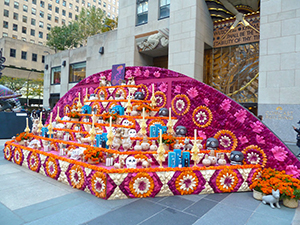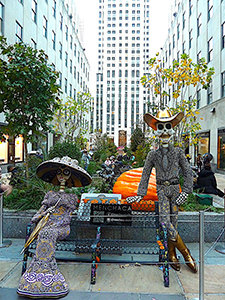
Many Americans have by now seen, purchased, or worn Día de los Muertos (Day of the Dead) events or merchandise, including NFL Day of the Dead jerseys, major league baseball Day of the Dead events and giveaways (Los Angeles Dodgers), Hollywood movies such as “Coco,” “The Book of Life,” and the James Bond film “Spectre,” Day of the Dead tattoos, Day of the Dead sneakers by Nike, as well as jewelry and other fashion accessories. Day of the Dead lottery tickets are now sold in nine U.S. states, the U.S. Post Office sells four styles of Day of the Dead postage stamps, and there are many more items and events promoting the celebration.
Older Americans may also remember a time not too long ago when Día de los Muertos was an unknown holiday in the U.S.,  raising the questions, what are the celebrations’ origins, and when and how did it become so widespread and commercialized?
raising the questions, what are the celebrations’ origins, and when and how did it become so widespread and commercialized?
A new edition of her popular book, “Day of the Dead in the USA: The migration and transformation of a cultural phenomenon, second edition” by Associate Professor of Journalism and Media Studies Regina Marchi, addresses these questions and more, looking at the role of the mass media in the growth of the celebration and the construction of ethnic identity. It will be released on August 12, 2022, in time for the 50th anniversary of the first documented celebrations of Día de los Muertos held in the U.S., which were started by Chicana/o artists in California in 1972.
It is important to understand the growth of this celebration, Marchi said, because its popularity relates to key discussions happening in the fields of Media Studies and Cultural Studies, as well as in fields such as Communication, Anthropology, Folklore, Ethnic Studies and Sociology regarding cultural hybridity, debates around “authenticity” (and its political uses), the socially constructed nature of ethnic identity, and the impacts of tourism, commodification and commercialization on ethnic cultures and populations.
“Culture is a highly political thing, and this book explores that via a very colorful topic,” Marchi said.
The book contains 50 percent new material and the main objective of the second edition is to document and analyze how the celebration - which is now a multi-media phenomenon in the U.S. (examples include public altar exhibits as a communication medium, poster art, visual art installations, spoken word events, musical performances, Aztec danza, skull crafts, skull face painting, fashion shows, film screenings, “low rider” car altars and more) - has evolved over the past 12 years, becoming even more widespread, more commercialized and more political (for example, public Day of the Dead altars honoring Black Lives Matter, #Me Too, victims of mass gun shootings, child migrants held in cages dying in U.S. detention centers, violence against LGBTQI+ populations, or the death of the environment). Marchi examines how all this has affected U.S. Latinx communities and the meanings of the celebration. The new edition also examines the influence of Day of the Dead on the growing “Death Positive” movement in the U.S.
Marchi said she began working on the revised edition when the publisher (Rutgers University Press) invited her to write an updated second edition because her first edition (published in 2009) has been widely used in classrooms across the country and has sold very well. The editors requested that she update it to cover various transformations of the celebration that have taken place during the past 12 years. To fund her research, Marchi applied for and received a Social and Racial Justice Grant from the Rutgers Social Science Research Council.
It will be released on August 12, 2022, in time for the 50th anniversary of the first documented celebrations of Día de los Muertos held in the U.S., which were started by Chicana/o artists in California in 1972.
In 2019, before the COVID pandemic, Marchi began her research by analyzing media coverage of U.S. celebrations from hundreds of newspapers and websites, including YouTube and other social media sites. “When I was doing research for the first edition,” Marchi said, “there wasn't much related to Day of the Dead on social media. But now there are literally thousands of YouTube videos, Instagram photos, Tweets, blogs, and websites related to Day of the Dead, and this book examines how this digital presence has affected the holiday, making it more widespread but also more commercialized.”
 She also completed and transcribed 30 new interviews with Latinx artists, educators, and other U.S. celebrants of the tradition, including many of the original Chicana/o artists who initiated the earliest Día de los Muertos celebrations in the U.S. fifty years ago.
She also completed and transcribed 30 new interviews with Latinx artists, educators, and other U.S. celebrants of the tradition, including many of the original Chicana/o artists who initiated the earliest Día de los Muertos celebrations in the U.S. fifty years ago.
Being able to speak again with many of these artists was a highlight of the research process for Marchi. “It was fascinating to hear their perspectives over time, since they have seen the celebration evolve over the past 50 years from being a completely unknown and ‘strange’ thing that many onlookers criticized as being ‘morbid’ and part of a ‘death cult’ to today, when it’s become the most widely known Latinx celebration in the world.”
The celebration’s popularity has spread beyond the U.S. to become a global phenomenon celebrated in many other countries, Marchi said, including Canada, Italy, Spain, France, Wales, Ireland, Australia, New Zealand, Scotland, and other places where Mexican and Central American migrants have come to live and work.
Marchi was deep into her research when the COVID lockdowns began, and she said this dramatically impacted the ways she conducted her work, in some ways enabling her to complete more work within the same timeframe, conducting most of her interviews via Zoom.
 While most art galleries and museums were physically closed in 2020 and 2021 due to pandemic lockdowns, many hosted virtual events, so Día de los Muertos celebrations and public altar exhibitions continued in communities and museums across the country. Marchi was able to attend, in real time, Day of the Dead celebrations happening at the Mexican Museum in Chicago, the Oakland Museum in CA, and Self Help Graphics and Art in Los Angeles – something she would not have been able to do in person due to the far distances between these places.
While most art galleries and museums were physically closed in 2020 and 2021 due to pandemic lockdowns, many hosted virtual events, so Día de los Muertos celebrations and public altar exhibitions continued in communities and museums across the country. Marchi was able to attend, in real time, Day of the Dead celebrations happening at the Mexican Museum in Chicago, the Oakland Museum in CA, and Self Help Graphics and Art in Los Angeles – something she would not have been able to do in person due to the far distances between these places.
“These virtual events were really interesting,” Marchi said, “because they enabled people from all over the country and the world to ‘attend’ Day of the Dead altar exhibitions in art galleries, museums and community centers, see Day of the Dead danza, music or theater performances, poetry events and concerts online, and feel connected to each other at a time when people were feeling very isolated.”
Marchi said the pandemic encouraged the creation of “virtual altars” and “car caravans” (in place of street processions) which the new book discusses as well. The book is available to pre-order now directly from the Rutgers University Press on their website.
Discover more about the Rutgers Department of Journalism and Media Studies on the website.
Photos: Día de los Muertos (Day of the Dead) in New York City. Courtesy of Associate Professor Regina Marchi.
In the Media 2023
The New York Times: "A Sweet Squash Offering for Día de los Muertos"
Woman's Day Magazine: "Día de los Muertos Traditions, Symbols and Facts to Know About the Holiday"
The Arizona Republic: "A Day Dedicated to Pets during Día de los Muertos: How a South Phoenix Org Celebrates It"
Mosaic,NJ.com: "This Day of the Dead stay away from skullduggery. Here are events with good, clean fun."
